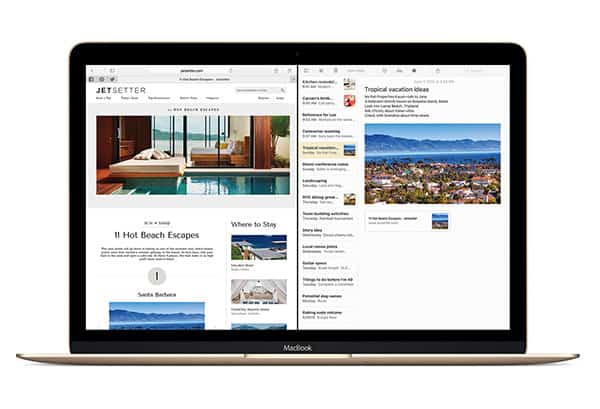
Above: Apple’s new splitscreen view in El Capitan is billed as a productivity booster. Photo courtesy Apple.
BitDepth#1013 for November 03, 2015
Longtime readers of this column will be aware that I’m an Apple guy when it comes to computers, though not necessarily so when it comes to computing.
I’ve run Windows in emulation since the old, achingly slow SoftWindows days and maintain a Parallels virtual environment which includes Windows 2000, Windows Vista and Windows 7. I use a Windows 10 tablet convertible and I’ve been an Android user on the Samsung S series for almost a decade now.
But when it comes to my desktop computing and main laptop axe, I remain a Mac guy because of the abundance of tools on the platform that target my professional specialties.
The Mac operating system, though, is changing inexorably. Into what, you might be asking? Well it looks set to turn into an iPad inspired OS and creates its own issues.
I’m a regular updater of Mac OS versions, albeit a cautious one, a trait that comes directly from the bad old days when system revisions could make a business to grind to a halt while software incompatibilities got sorted out.
There was an actual bit of software called Conflict Catcher which did a bit of digital shell gaming to figure out which new addition to your system software had managed to break it.
Ever since Apple successfully migrated its user experience to a Unix engine (around version 10.02), it’s become rather less common for the average user to experience Mac OS hiccups.
In recent years, the software and hardware synergy has developed so far that system freezes, once a commonplace part of my working day, are more likely to elicit the kind of curious expression that the sudden appearance of a transluscent black screen featuring foreign languages deserves when it appears in your life.
One thread of clues about Apple’s intentions for its development of OSX has been clearly visible in its naming conventions.
Apart from a strict numerical taxonomy that identifies major upgrades and interim patches, the company has maintained unofficial and official codenames for its OS releases.
Between 2001 and 2012 those codenames referenced great cats of the wild, with an initial emphasis on speedy felines.
Since 2013, the naming has shifted to points of interest in California and the last two releases, Yosemite (10.10) and El Capitan (10.11) point to an emphasis on robust rock formations, which mirror a software side shift from features and speed to stability.
Those changes include a quiet burial for OS9 software with 2011’s Lion (10.7) and the introduction in that OS of Gatekeeper, an effort by the company to extend the safety checks it makes on its Mac App Store to software that users download from the web.
Software developers were expected to apply for a Developer ID, which would allow users to install software from outside the Mac App Store. That option was not the default, creating some confusion when users updated, but Apple still makes it possible for its customers to either add identified developers to Gatekeeper or to turn the feature off completely.
With the new System Integrity Protection (SIP) feature built into El Capitan, Apple locks down its OS even more tightly.
The feature dramatically restricts access to the root of the OS, which is generally a bad thing only for hackers and the programmers of malware.
If your favorite bit of Apple software relies on sneaky software routines that run afoul of SIP, it’s going to break.
I’ve lost, at least temporarily, the use of one such product to SIP, St Clair Software’s Default Folder X, something I’ve been using since OS7, but that programmer is working on an update. Disabling SIP requires user comfort with Terminal and isn’t a casual button click away.
More befuddling was a lingering problems with restarting the OS on several occasions which I tracked down on the web to a list of errant .kext files, the extension code which links the OS to nonstandard devices.
Beyond that, the feature list for El Capitan, which like every release since Mavericks (10.9) has been issued without charge, is pretty slim for most practical purposes.
While significantly improved OS stability is a major feature all on its own, most of the changes continue to be subtle tweaks that make Mac OSX look and behave more like iOS, something that’s sure to please Apple’s iPad and iPhone users even as it annoys the Macintosh faithful.


